
Pietra portafortuna di marzo: una guida completa + pietre alternative
Per i compleanni che inaugurano la stagione primaverile, i nati a marzo hanno due pietre portafortuna ufficiali. Le due pietre portafortuna di marzo sono l'acquamarina e l'eliotropio, entrambe con aspetti contrastanti ma con una tradizione altrettanto ricca.
Il mese di marzo prende il nome da Marte, il dio romano della guerra, perché era il momento in cui i soldati romani riprendevano le campagne dopo il rinvio per l'inverno. Tecnicamente, marzo (o Marzio) era il primo mese del calendario romano prima dell'aggiunta di gennaio e febbraio per allinearsi meglio con l'anno lunare.
Oltre al ritorno alle battaglie, gli antichi tornarono anche all'agricoltura e ai viaggi, con l'equinozio di primavera il 20 marzo (o equinozio d'autunno nell'emisfero australe). Si celebravano numerose feste, la maggior parte delle quali celebravano Marte o il nuovo anno.
Oggi, marzo simboleggia nuovi inizi, rinascita e speranza per il futuro. Inoltre, il mese celebra l'uguaglianza come Mese della storia delle donne, oltre alla Giornata internazionale della donna, l'8.
Dopo aver chiarito il significato del mese di marzo, approfondiremo i significati, la storia e le proprietà delle due pietre portafortuna di marzo: l'eliotropio e l'acquamarina .
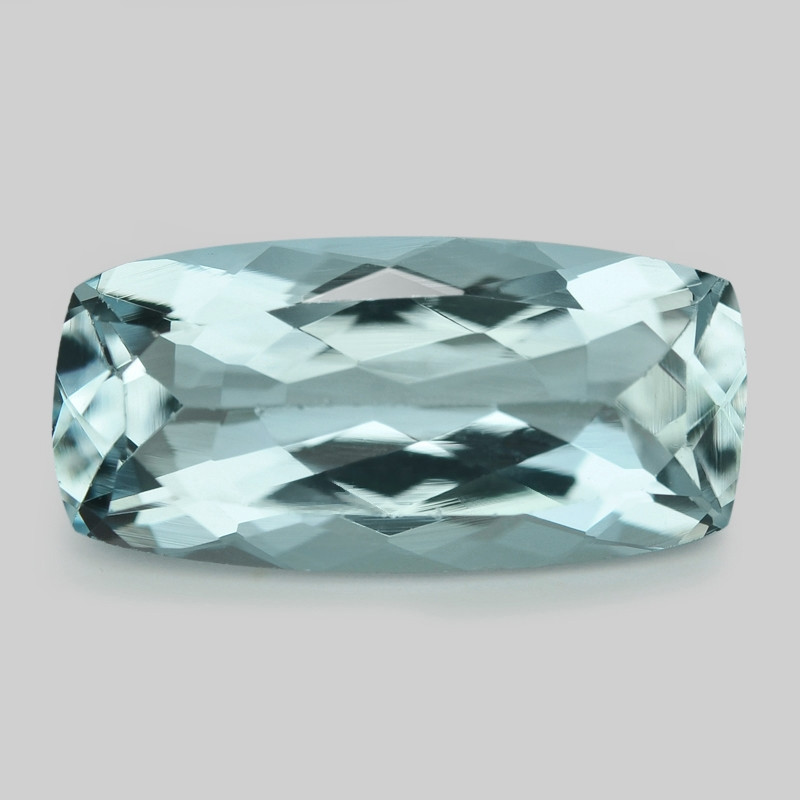
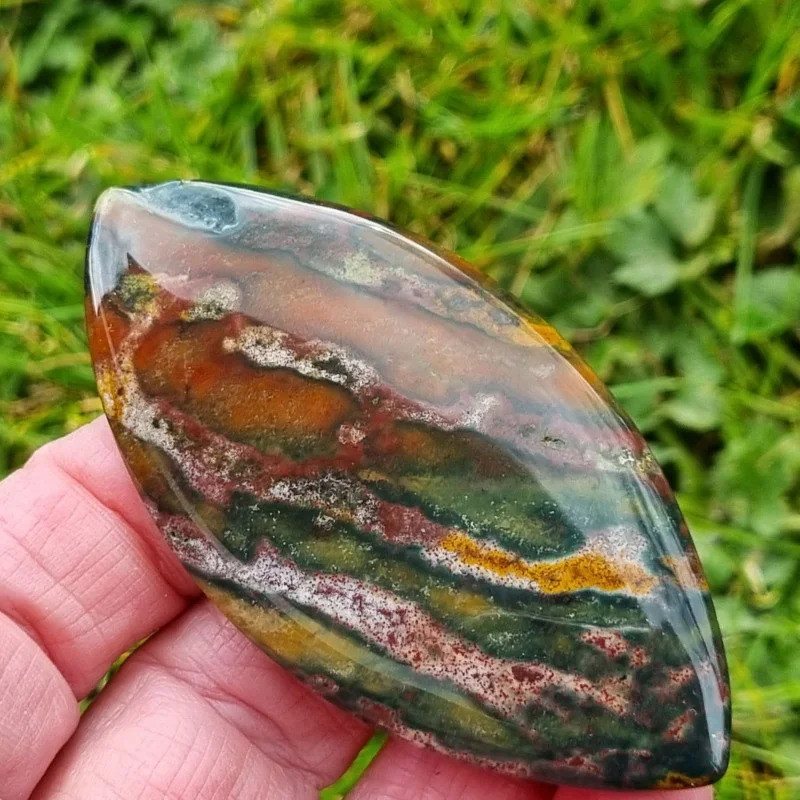 Nella foto sopra: pietra preziosa di acquamarina sfaccettata (in alto), cabochon di eliotropio (in basso)
Nella foto sopra: pietra preziosa di acquamarina sfaccettata (in alto), cabochon di eliotropio (in basso)
Quali sono le pietre portafortuna di marzo?
Marzo ha due pietre portafortuna tradizionali: l'acquamarina e l'eliotropio. Queste gemme semipreziose sono altrettanto leggendarie, ma presentano forti contrasti:
Colore : l'acquamarina ha delle tonalità tenui che vanno dal verde mare al blu cielo; l'eliotropio ha una colorazione verde foresta intenso con spruzzi cremisi.
Trasparenza : le gemme di acquamarina sono solitamente trasparenti; le gemme di sangue sono solitamente opache.
Forme delle pietre preziose : le acquamarine sono solitamente sfaccettate ; le gemme sanguigne sono solitamente tagliate a cabochon .
Anniversari di matrimonio : l'acquamarina è la gemma tradizionale del 18° anniversario di matrimonio , mentre l'eliotropio è una gemma alternativa per il 14° anniversario.
Ma perché ci sono due pietre portafortuna per marzo? In breve: storia!
Origini delle pietre portafortuna di marzo
La tradizione relativa alle pietre portafortuna risale al I secolo d.C. , quando gli storici collegarono gli elenchi biblici di 12 pietre ai 12 mesi dell'anno e ai 12 segni zodiacali.
Nelle prime liste delle pietre natali, l'eliotropio era l'unica pietra natale di marzo.
Tuttavia, l'identificazione accurata delle gemme non arrivò per molto tempo, quindi le pietre effettivamente menzionate nei testi antichi sono oggetto di dibattito. Inoltre, le persone non iniziarono a indossare le pietre natali del proprio mese di nascita fino a quando i gioiellieri in Germania o Polonia iniziarono a vendere gioielli con pietre natali intorno al 1500 .
Gli elenchi standardizzati che conosciamo oggi risalgono al 1800 circa, quando Tiffany & Co. pubblicò poesie sulle pietre natali nel 1870 , attribuite a un autore gregoriano anonimo.
Ecco la poesia di marzo tratta da quell'opuscolo:
“Da colei che nacque a marzo
Nessuna gemma, eccetto la Pietra del Sangue, deve essere indossata
Garantiranno la sua costanza
Vera amicizia e fedeltà."
Nel 1912 , la National Association of Jewellers (ora Jewellers of America) creò un elenco standardizzato delle pietre natali. Il Jewelry Industry Council of America aggiornò l'elenco nel 1952 e ne nacquero altri (in gran parte simili).
In queste liste, l'acquamarina veniva proposta come alternativa all'eliotropio.
Oggigiorno, le liste delle pietre portafortuna britanniche e americane danno la priorità all'acquamarina rispetto all'eliotropio, ma le elencano comunque entrambe.
Quindi, la pietra portafortuna di marzo è l'acquamarina o l'eliotropio? Entrambe! Potremmo definire l'eliotropio la pietra portafortuna "tradizionale" e l'acquamarina quella "moderna".
Parlando di tradizioni, diamo un'occhiata alla storia di queste due pietre preziose.
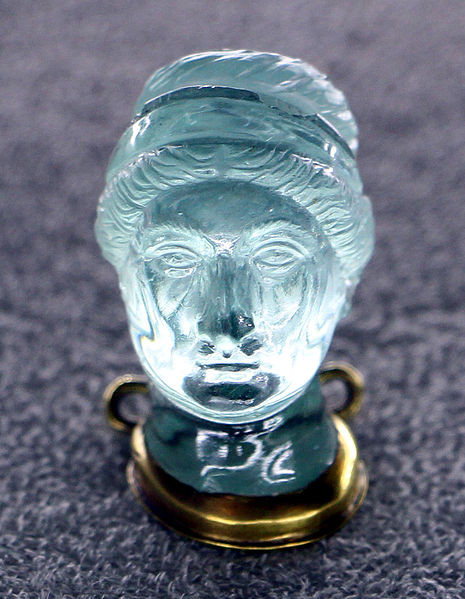 Nella foto sopra: Arte antica, testa di imperatrice in acquamarina, forse Matidia, restaurata in oro alla base; Datata II secolo (descrizione tradotta dall'italiano) | Crediti immagine: Sailko, CC-BY-SA-3.0
Nella foto sopra: Arte antica, testa di imperatrice in acquamarina, forse Matidia, restaurata in oro alla base; Datata II secolo (descrizione tradotta dall'italiano) | Crediti immagine: Sailko, CC-BY-SA-3.0
Contesto storico e culturale delle pietre natali di marzo
Una qualità che accomuna le due pietre portafortuna di marzo è la loro storia ricca e variegata, piena di leggende e tradizioni!
Usi storici dell'acquamarina
Il nome acquamarina deriva dai termini latini aqua , "acqua", e marine , "mare", per la sua somiglianza con l'acqua di mare. Sebbene questo appellativo sia stato coniato nel 1609, il nome precedente, " berillo verde mare", era noto da secoli.
Gli antichi credevano che la pietra portafortuna di marzo offrisse protezione in mare, e spesso la incidevano per creare talismani. Le leggende sulle origini dell'acquamarina spaziavano dal tesoro perduto delle sirene alla sua creazione da parte del dio del mare Poseidone (o Nettuno).
Molti antichi associavano l'acquamarina alla gioia della giovinezza e alla passione dei giovani amori.
Nel Medioevo si credeva che l'acquamarina proteggesse dagli avvelenamenti (il che la rendeva popolare tra i reali) e facilitasse le capacità psichiche.
I cristiani associavano l'acquamarina a San Tommaso, patrono dei marinai. Alcuni credevano anche che la gemma favorisse matrimoni felici.
Anche i buddisti credevano che l'acquamarina simboleggiasse l'amore. Una tradizione in India prevede di regalare gioielli di acquamarina agli sposi novelli.
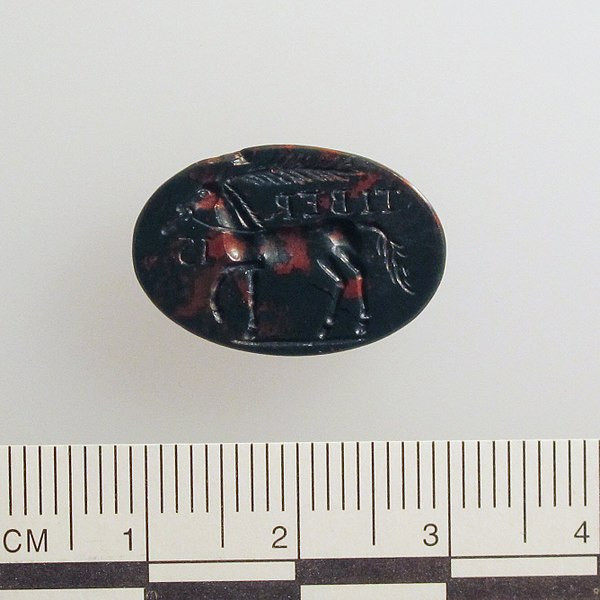 Nella foto sopra: intaglio eliotropo romano imperiale raffigurante anguipes con testa di gallo (divinità con serpenti al posto delle gambe), datato III secolo d.C., esposto al Metropolitan Museum of Art | Crediti immagine: Met Museum, di pubblico dominio
Nella foto sopra: intaglio eliotropo romano imperiale raffigurante anguipes con testa di gallo (divinità con serpenti al posto delle gambe), datato III secolo d.C., esposto al Metropolitan Museum of Art | Crediti immagine: Met Museum, di pubblico dominio
La pietra di sangue in contesti storici e mistici
Il nome "pietra sanguigna" si riferisce alla sua tipica colorazione rosso sangue, a forma di goccia.
Tuttavia, l'antico nome greco era " eliotropio ", derivato dai termini helios , che significa "sole", e trepo , che significa "girare", perché la pietra appariva completamente rossa al tramonto o quando veniva posta sott'acqua alla luce diretta del sole.
Gli antichi utilizzavano l'eliotropio per scopi pratici e mistici.
I babilonesi crearono sigilli in pietra sanguigna e i nobili indossavano anelli con sigillo in pietra sanguigna per timbrare documenti importanti. Anche i mesopotamici e i babilonesi usavano la pietra sanguigna per la divinazione, mentre Egizi, Romani e Greci credevano che la pietra portafortuna di marzo li rendesse più forti in battaglia o negli sport.
L'antico studioso romano Plinio il Vecchio scrisse che le pietre del sangue erano specchi del sole, permettendo di vedere le eclissi solari. Un altro antico autore romano, Damigerone, scrisse che le pietre del sangue predicevano il futuro e, "se messe in un bacile d'argento pieno d'acqua e poste contro il sole, si rivolgono verso di esso e lo rendono come sanguinoso e torbido".
Le eliotropi incise con soli o torce venivano spesso indossate dagli schiavi liberati per simboleggiare la loro liberazione.
Un soprannome comune era " pietra del martire ", che alla fine portò al nome "pietra di sangue".
Una leggenda cristiana nacque sull'origine dell'eliotropio durante la crocifissione di Gesù Cristo. La storia narra che la pietra si formò quando il sangue di Cristo cadde sulla terra verde o su un diaspro verde sotto la croce (le leggende divergono). Pertanto, alcuni credevano che la pietra guarisse i problemi legati alla circolazione sanguigna.
Nel Medioevo , il legame con il martirio persistette attraverso sculture in pietra sanguigna che raffiguravano atti di martirio e amuleti che si credeva rappresentassero il sacrificio di Cristo.
Gli europei medievali preparavano elisir di eliotropio per curare emorragie, tumori e morsi di serpente. In India , l'eliotropio in polvere veniva usato come afrodisiaco.
Oggigiorno, l'India è una delle principali fonti di eliotropio, e questo ci porta alle origini di questi cristalli di marzo!
 Nella foto sopra: Acquamarina grezza
Nella foto sopra: Acquamarina grezza
Origini geologiche e proprietà delle pietre portafortuna di marzo
L'acquamarina è una varietà di berillo. Le pietre di berillo sono piuttosto resistenti, con una durezza compresa tra 7,5 e 8 sulla scala di Mohs . Questi minerali si formano solitamente nelle pegmatiti di granito che contengono berillo.
Le impurità presenti determinano la gamma di colori, come il ferro ferroso o ferrico che caratterizza le tonalità blu-verdi dell'acquamarina. Inoltre, gruppi paralleli o perpendicolari di inclusioni a forma di tubo cavo possono dare origine a un leggero gatteggiamento (effetto "occhio di gatto") o a un asterismo (effetto "stella"). Alcune delle migliori acquamarine provengono dalla Siberia e dal Brasile.
L'eliotropio è una varietà di calcedonio , o quarzo microcristallino. Alcuni lo classificano come un tipo di diaspro , una sottocategoria del calcedonio per le pietre opache e decorate.
La formazione di questa pietra portafortuna di marzo è simile a quella di altri quarzi, ma le macchie rosse derivano da inclusioni di ematite . La maggior parte delle gemme di ematite sanguinea proviene dall'India.
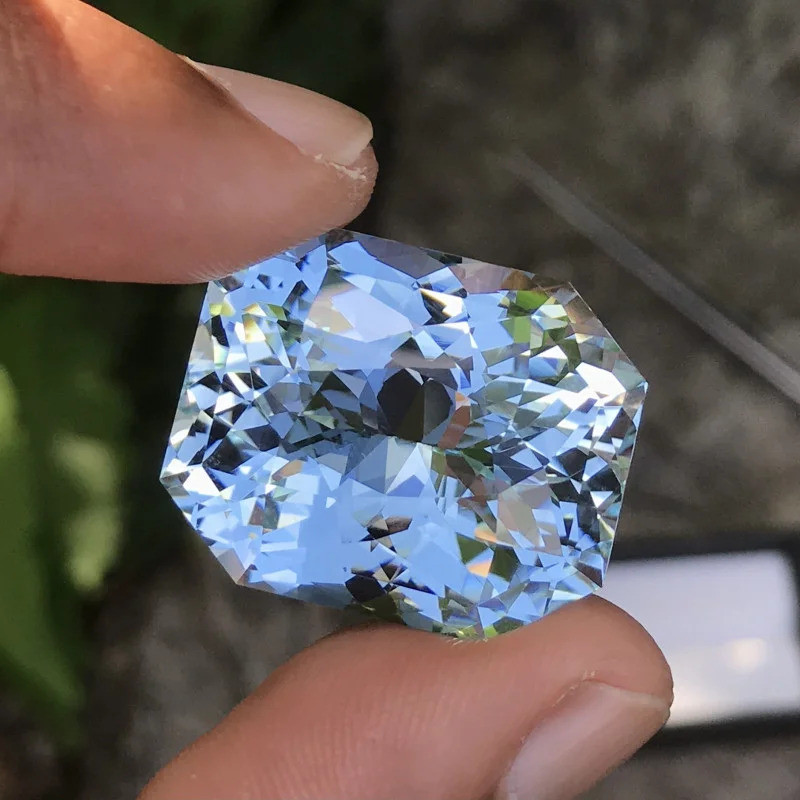 Nella foto sopra: Acquamarina blu Santa Maria sfaccettata
Nella foto sopra: Acquamarina blu Santa Maria sfaccettata
Sfumature di blu e verde: la delicata palette di colori dell'acquamarina
Nonostante i suoi colori varino solo dal blu al verde, la tavolozza dei colori dell'acquamarina è sorprendentemente varia. I valori più alti si riferiscono a tonalità di blu più pure e sature, ma di solito i colori di queste pietre natali di marzo sono un blu-verde pallido.
Alcuni colori hanno nomi commerciali distinti:
Santa Maria : blu medio-scuro, ad alta saturazione; scoperto nella miniera di Santa Maria de Itabira in Brasile
Espirito Santo : saturazione del blu inferiore a quella di Santa Maria, ma brillantezza unica e colore profondo
Maxixe : colore blu molto scuro; raramente si trova in natura nella miniera di Maxixe in Brasile; solitamente prodotto tramite un trattamento di irradiazione instabile (tendente allo sbiadimento)
Nampula : uovo di pettirosso blu; si trova nella provincia di Nampula, in Mozambico.
Pedra Azul : blu ghiaccio; si trova nel distretto di Pedra Azul in Brasile
Poiché i colori blu più puri sono più preziosi, molte gemme di acquamarina vengono trattate termicamente per rimuovere le sfumature verdi.
Ora, che aspetto ha una pietra sanguigna?
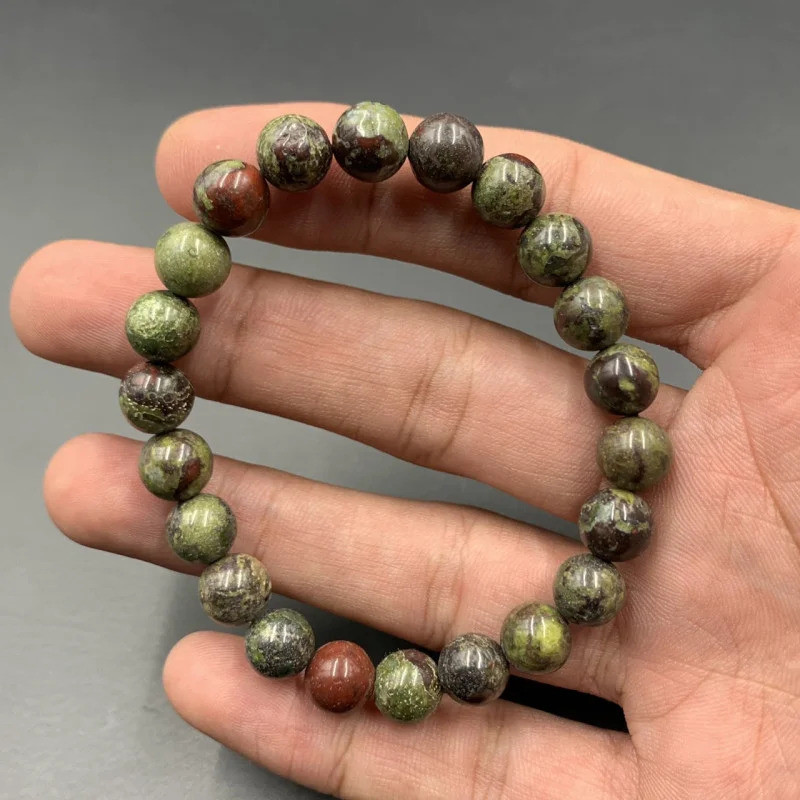
Il misticismo di Bloodstone: macchie verdi e rosse intense
Tecnicamente, l'eliotropio è considerato un tipo di plasma, una varietà di calcedonio di colore verde semitrasparente o opaco, con macchie gialle, bianche o rosse.
L'aspetto classico della pietra portafortuna dell'eliotropio è verde foresta con macchie rosse. Le macchie e talvolta le striature sull'eliotropio possono anche essere arancioni, marroni, bianche, gialle o una combinazione di queste tonalità terrose.
Oltre alle inclusioni di ematite rossa, tra le altre inclusioni minerali che contribuiscono alla colorazione dell'eliotropio ci sono l'anfibolo, la clorite e il pirosseno.
Alcuni classificano le pietre sanguigne "eliotrope" come traslucide con macchie rosse e le pietre sanguigne "plasmatiche" come opache con pochissime macchie rosse.
Alcune varianti con nomi commerciali:
Diaspro sanguigno : macchiato di rosso-nero con venature bianche
Diaspro fantasia : colori predominanti oltre al verde e al rosso, o combinazioni di colori varie
Oltre all'apparenza, un'altra differenza tra acquamarina e diaspro sanguigno riguarda il loro significato spirituale e il loro utilizzo come pietre curative .
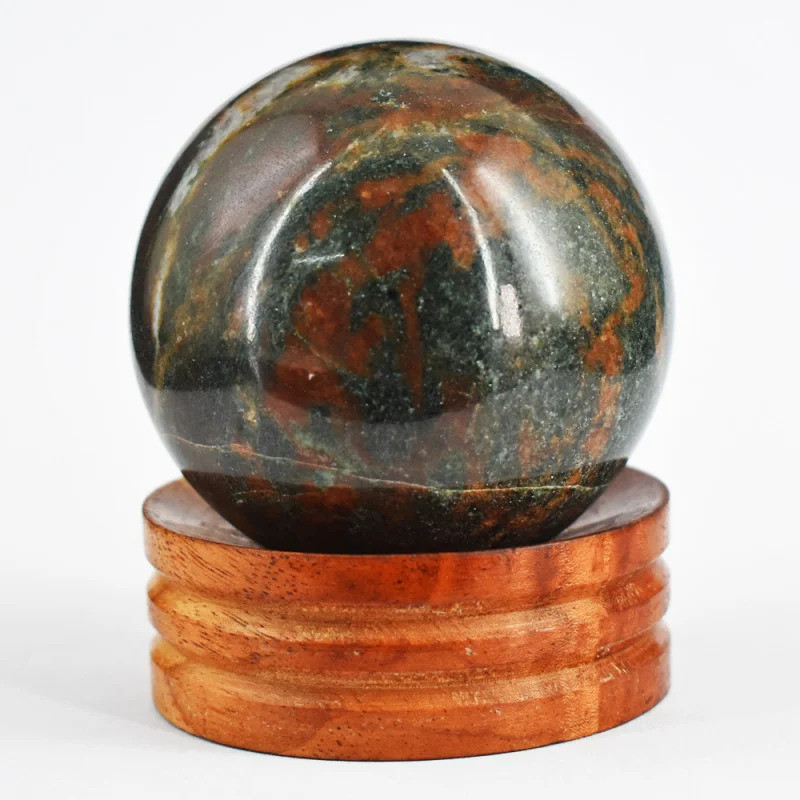 Nella foto sopra: sfera curativa di eliotropio
Nella foto sopra: sfera curativa di eliotropio
Significato spirituale e metafisico
Il significato dell'acquamarina, pietra portafortuna del mese di nascita, è di purificazione, serenità e giovinezza. L'eliotropio, invece, simboleggia forza, resistenza e sacrificio.
Nella guarigione energetica, l'acquamarina è una pietra chakra per il chakra della gola, mentre l'eliotropio apre il chakra della radice (base).
Tuttavia, alcuni significati delle pietre portafortuna di marzo si sovrappongono:
Coraggio : si dice che entrambe le pietre rafforzino il coraggio: l'acquamarina si concentra sull'auto-potenziamento per dire con coraggio la propria verità, mentre l'eliotropio si concentra sul coraggio fisico per perseguire i propri sogni.
Purificante : ogni pietra può avere proprietà purificanti e purificanti, eliminando la negatività e aiutandoti a ripartire da zero.
Superare gli ostacoli : si ritiene che l'acquamarina aiuti ad affrontare gli ostacoli emotivi, come la comunicazione in una relazione. L'eliotropio è considerato protettivo e aiuta a superare gli ostacoli al successo.
Astrologicamente, l'acquamarina si sposa perfettamente con la sensibile energia acquatica dei Pesci (nati dal 19 febbraio al 20 marzo). L'eliotropio, invece, riflette l'ardente e ambizioso Ariete (nati dal 21 marzo al 19 aprile), governato da Marte.
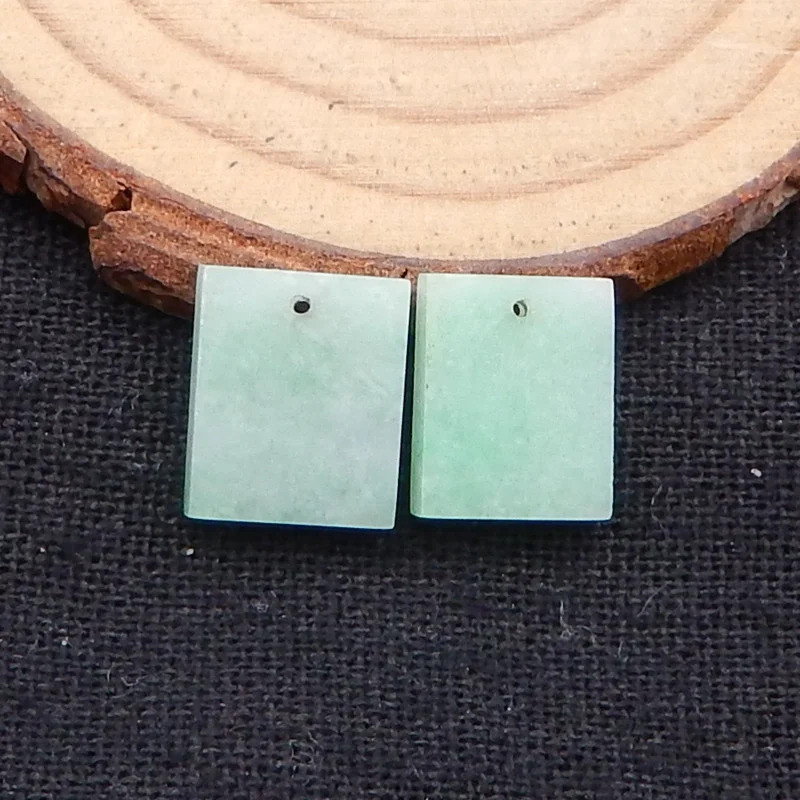 Nella foto sopra: orecchini in giada intagliata
Nella foto sopra: orecchini in giada intagliata
Esplorando le pietre portafortuna alternative di marzo
L'acquamarina e l'eliotropio non fanno per te? Hai altre opzioni!
La mistica pietra portafortuna di marzo, che affonda le sue radici nell'antica astrologia tibetana, è la giada , che racchiude la dolcezza della primavera e la resistenza di Marte.
Una seconda pietra portafortuna alternativa per i nati a marzo è il diaspro , simile all'eliotropio ma con maggiore varietà.
Un'altra opzione verde è lo smeraldo , la pietra portafortuna della primavera. Sorella berillo dell'acquamarina, lo smeraldo ha una colorazione verde più intensa e rappresenta anche la nuova crescita.
Per quanto riguarda il prezzo, l'eliotropio è molto più accessibile, mentre l'acquamarina può essere costosa per alcuni.
Alcune alternative più convenienti alla pietra portafortuna acquamarina:
Si può anche optare per un'acquamarina sintetica , creata in laboratorio ma che presenta le stesse proprietà chimiche e fisiche dell'acquamarina naturale.
 Nella foto sopra: la regina Elisabetta II indossa la sua tiara color acquamarina (descritta di seguito) al banchetto di Stato brasiliano del 7 marzo 2006 | Crediti immagine: Agência Brasil, CC-BY-SA-3.0 | File originale
Nella foto sopra: la regina Elisabetta II indossa la sua tiara color acquamarina (descritta di seguito) al banchetto di Stato brasiliano del 7 marzo 2006 | Crediti immagine: Agência Brasil, CC-BY-SA-3.0 | File originale
Design di gioielli contemporanei e famosi
Sia l'acquamarina che l'eliotropio sono stati utilizzati in molti gioielli dal design esclusivo nei tempi moderni.
Acquamarina
Come pietra portafortuna del mese di marzo o semplicemente come splendido accessorio, le gemme sfaccettate di acquamarina brillano con una colorazione delicata ma con una radiosità intensa.
Gli anelli con pietra portafortuna acquamarina (o anelli di fidanzamento) sono molto popolari, spesso incastonati accanto a pietre decorative bianche o di colore chiaro, come i diamanti bianchi.
Alcuni esempi famosi di gioielli con acquamarina includono:
Tiara di acquamarina della regina Elisabetta : commissionata dalla regina Elisabetta d'Inghilterra nel 1957, Garrard creò questa tiara in platino con acquamarine brasiliane e diamanti, donatile dal presidente brasiliano Getúlio Vargas nel 1953. Il governatore di San Paolo donò un'acquamarina più grande per sostituire la pietra centrale nel 1971.
Pendente con acquamarina Hirsch : quest'acquamarina taglio smeraldo da 109,92 carati è incastonata in un pendente in oro bianco con 118 micro diamanti incastonati a pavé. Apparteneva all'imperatore francese Luigi XV, che si dice ne sfruttasse le proprietà calmanti.
Anello di fidanzamento di Meghan Markle : questo anello in oro giallo ha una pietra centrale di acquamarina azzurra taglio smeraldo da 13 carati con diamanti più piccoli. L'anello è stato realizzato da Asprey e donato a Diana da Lucia Flecha de Lima intorno al 1996. Il figlio di Diana, il Principe Harry, ha regalato l'anello a Meghan Markle, che lo ha indossato il giorno delle loro nozze nel 2018.
Pietra del sangue
A differenza dell'acquamarina, l'eliotropio è una pietra ricca, terrosa e pesante, i cui colori riflettono queste caratteristiche.
La pietra portafortuna di marzo viene solitamente tagliata a cabochon o intagliata, quindi molti gioielli con eliotropio sono pendenti o bracciali con perline. Tuttavia, anelli con eliotropio intagliati o cabochon che ricordano stili antichi stanno guadagnando popolarità, soprattutto con splendide montature in oro.
L'eliotropio non compare in molti gioielli reali, ma una pietra del sangue reale (probabilmente la più famosa) è il sigillo dell'imperatore del Sacro Romano Impero Rodolfo II (1552-1612). Esposto al Museo del Louvre di Parigi, il sigillo dell'imperatore è inciso su questa pietra del sangue.
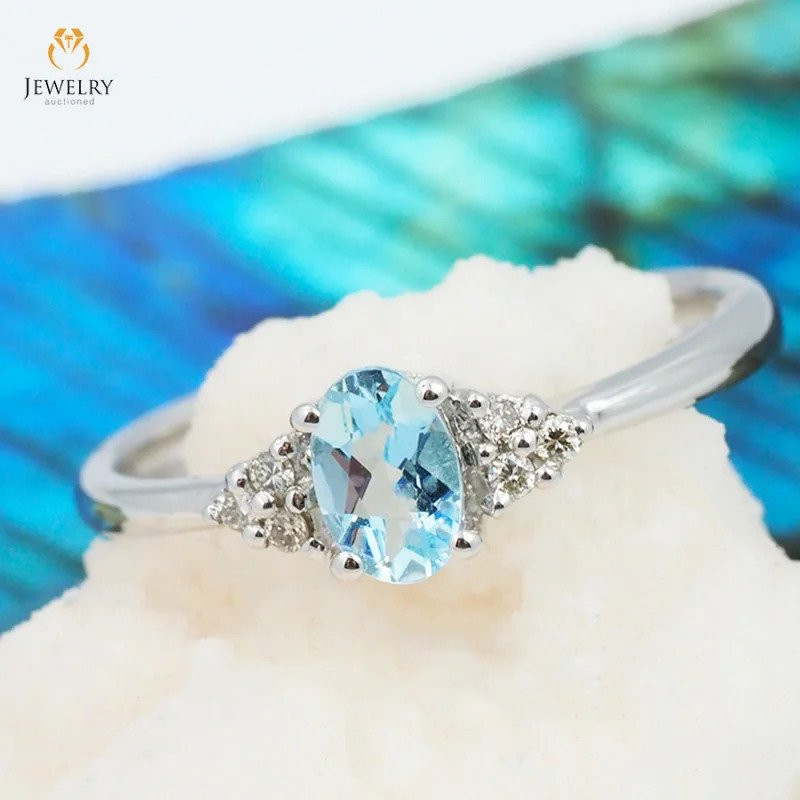
Quale pietra portafortuna di marzo ti si addice?
Vi sentite attratti dalla delicata ed eterea acquamarina o dalla ricca e terrosa eliotropio? Entrambe le pietre portafortuna di marzo offrono coraggio e guarigione, e al contempo si sposano perfettamente con l'associazione del mese con i nuovi inizi. In ogni caso, entrambe le pietre, nei gioielli con pietre portafortuna di marzo, hanno un fascino senza tempo!
Cerca il Gemstone Encyclopedia
Aste correlate
articoli Correlati
In origine, le pietre portafortuna o gemme erano associate a un segno zodiacale o al mese di nascita di un individuo. Scopri qual è la tua pietra e guarda le pietre che abbiamo in vendita.
8th Feb 2021
L'ammolite è una gemma canadese iridescente, ricavata da gusci fossilizzati di creature estinte chiamate ammoniti. Scopri i benefici, le proprietà, il valore e molto altro dell'ammolite!
6th Apr 2020
I diamanti sono gemme di carbonio incolore e brillanti, note per la loro durevolezza, prestigio e popolarità negli anelli di fidanzamento. Scopriamo insieme la storia, il significato e il valore del diamante!
19th Mar 2020
Articoli Recenti
La pietra del sole a reticolo arcobaleno è una varietà di feldspato con tre splendidi effetti ottici dovuti alla presenza di varie inclusioni. La sua colorazione infuocata e il suo motivo a reticolo la rendono una gemma rara da collezione!
12th Jan 2026
Thulite is a rare Norwegian gemstone exhibiting a vibrant rosy hue from the zoisite mineral family that is commonly used in jewelry settings and pendants.
6th Jan 2026
La bismutotantalite è una rara gemma minerale appartenente alla famiglia della tantalite. È relativamente morbida, il che la rende inadatta all'incastonatura in gioielleria. Tuttavia, è un prezioso oggetto da collezione.
5th Jan 2026
Categorie di articoli
How To's is where you will find helpful articles from gem Rock Auctions on how to cut gemstones, select gemstones and buy gemstones.
9 Articoli




